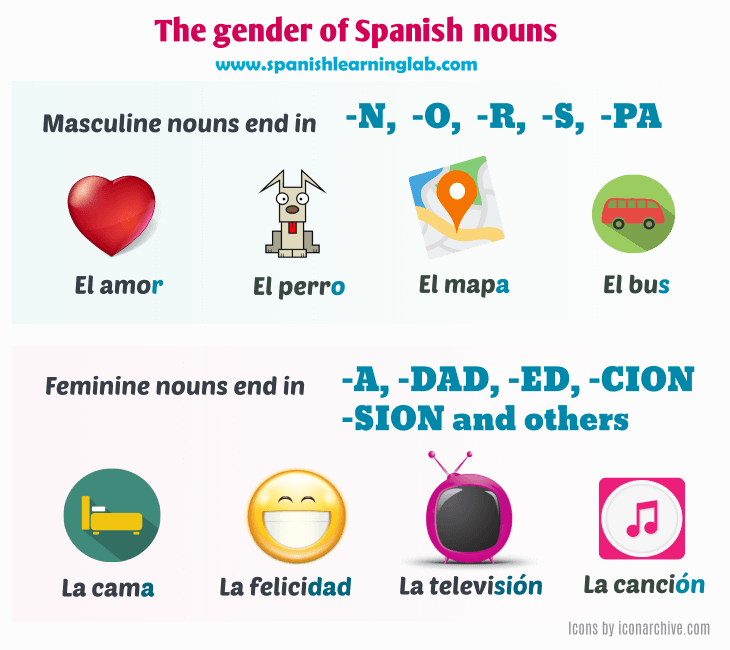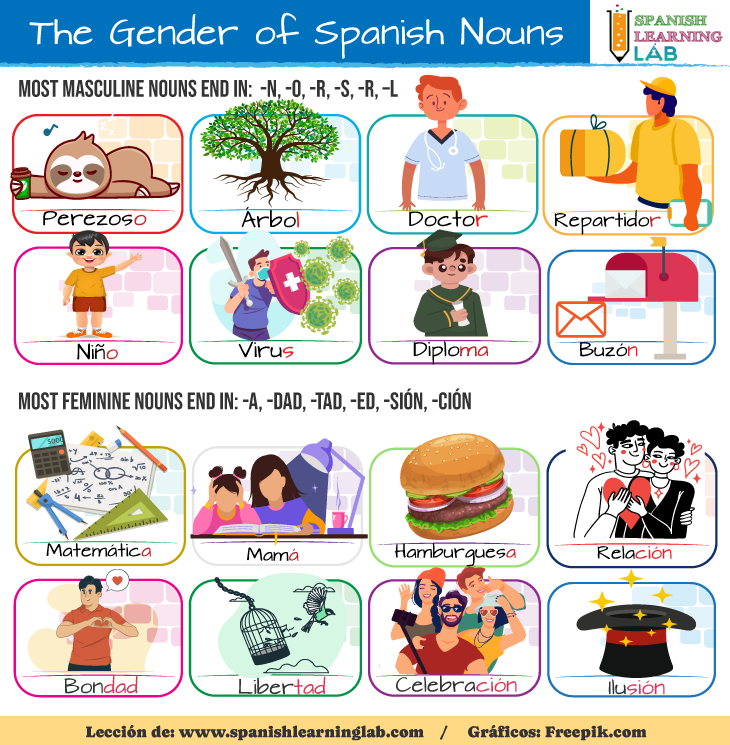Spanish nouns normally have either a feminine or a masculine form. This interesting feature makes them kind of different and challenging at the same time when compared to the way nouns are used in other languages. Luckily, there are some simple rules to recognize masculine and feminine nouns in Spanish, and we are certain that you will remember them easily with all the examples in this lesson. Let’s start…
The basic rules for the gender of Spanish nouns
As a general rule, we recognize the gender of nouns in Spanish by looking at the word’s ending. Masculine words usually end in the vowels E or O like PADRE and MAESTRO, whereas feminine words end in the vowel A such as HERMANA and CASA. The picture below introduces some examples of common masculine and feminine nouns in Spanish.

Recognizing masculine nouns in Spanish: list and examples
You will recognize masculine nouns in Spanish, los sustantivos masculinos, because these words end in the letters -N, -O, -R, -S, -R, –L. Two examples of common masculine nouns are CORAZÓN (heart) and CARRO (car). In addition, just a few masculine nouns end in the syllables –MA, -PA and –TA, just like the word PROBLEMA and MAPA, as shown in these sentences:
- El pastel está delicioso. (The cake is delicious.)
- El dinosaurio se comió a la vaca. (The dinosaur ate the cow.)
- ¿Puedes revisar el mapa por favor? (Can you check the map, please?)
Not all the words ending in those syllables are actually masculine nouns, e.g. “CAPA” (cape) or “TAPA” (lid). In addition, there are some feminine nouns in Spanish that may end in -L and -MA such as: CÁRCEL (jail) and MAMÁ (mom).
There are always exceptions to the rules for the gender of nouns, so pay attention to certain clues like the definite article or indefinite article that precedes the word, or even the subject pronoun that is being used in the sentence, for example:
- Él es mi papá (the pronoun “ÉL” tells that we are talking about a masculine noun)
- Ayúdame a pelar las papas. (Help me to peel the potatoes – PAPA with no tilde means potato, and it becomes a feminine noun)
In general, you will not see or listen to isolated words in the language, so the rest of the words in the sentence and their spelling will be crucial to determine the gender of nouns in Spanish.
Some examples of sentences using a list of masculine nouns in Spanish
| Carro (ends in -o) – El carro rojo es suyo The red car is his/hers |
|
Corazón (ends in –o + -n) – Mi corazón está saludable
My heart is healthy
|
|
Color (ends in -o + -r) – Mi color favorito es el verde
Green is my favorite color
|
|
Planes (ends in -s) – Tengo planes para hoy
I have plans for today
|
|
Arte (ends in – e) – Amo el arte
I love art
|
|
Pincel (ends in -l) – Este es mi pincel
This is my brush
|
|
Mapa (ends in -pa) – Un mapa antiguo
An old map
|
|
Problema (ends in -ma) – Tenemos un gran problema
We have a big problem
|
|
Planeta (ends in -ta) – Es un planeta gigante
It is a giant planet
|
Identifying feminine nouns in Spanish: list and examples
“Los sustantivos femeninos” or feminine nouns usually end in the letters -A, -DAD, -TAD, -ED, -SION, -CIÓN, -DEZ, -TIS, -IZ and some end in -E too. Again, these endings are not absolute, so you may still find a few masculine nouns in Spanish ending in those letters as well.
Sentences using a list of feminine nouns in Spanish
|
Casa (ends in -a) – Su casa es muy grande
Her house is very big
|
|
Amistad (ends in -tad) – Nuestra amistad es importante
Our friendship is important
|
|
Pared (ends in -ed) – La pared de la cocina
The kitchen’s wall
|
|
Misión (ends in -sión) – Esa es la nueva misión
That’s the new mission
|
|
Canción (ends in -ción) – ¿Te gusta la canción?
Do you like the song?
|
|
Honestidad (ends in -dad) – ¿Qué es la honestidad?
What’s honesty?
|
|
Actriz (ends in -iz) – Ella es actriz
She is an actress
|
Wrapping up!
Keep in mind that some words can change from masculine to feminine, and vice versa, e.g. Doctor -> Doctora or Niño->Niña. Some nouns are always masculine, like “Virus“, whereas others are always feminine, like “Mamá“. The ability to identify whether one belongs to one group or the other comes from real practice, through reading or speaking the language a bit often. Identifying the gender of nouns in Spanish is not an easy task, but practice makes perfect. Here is a nice image illustrating common Spanish words and their gender:

Confusing Spanish nouns (invariant gender)
Finally, some nouns could be treated as masculine and feminine nouns. They are usually called SUSTANTIVOS INVARIABLES. The article or pronoun that is placed before them help us determine their gender and meaning. Some of them change their meaning depending on the article they are used with. For example, the noun CURA seems to be a feminine noun, but when add the article EL and say “El cura” then it becomes a priest, but if we add the feminine article LA then it becomes “La cura” (the cure). You can learn more with this video, which explains how a slight change in articles affects the meaning of words.
Sentences using Spanish invariant nouns
|
Estudiante (ends in -e) – Ella es estudiante
She is a student
|
|
Estudiante (ends in -e) – Él es estudiante
He is a student
|
|
Dentista (ends in -a) – Carlos es dentista
Carlos is a dentist
|
Related Spanish Worksheets:
- Classifying Nouns in Spanish – PDF Worksheet
- Singular and Plural Nouns in Spanish – PDF Worksheet
- Spanish Nouns Gender and Number – PDF Worksheet
- Subject Pronouns in Spanish – PDF Worksheet
